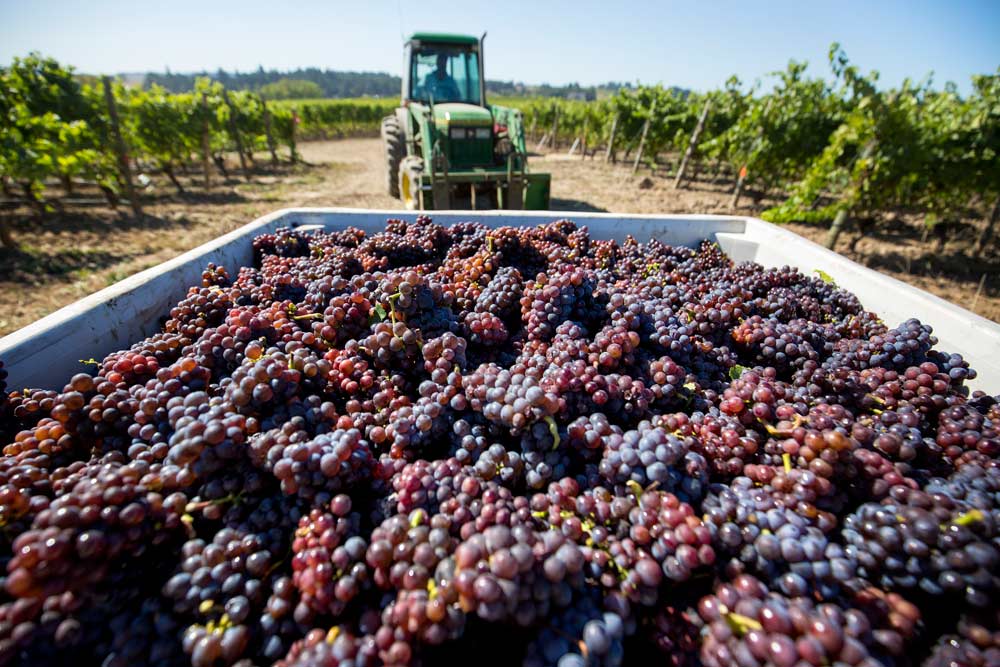
Pinot Noir grapes harvested in the Willamette Valley, Oregon, on September 14, 2016. (TJ Mullinax/Good Fruit Grower)
This is no chicken or egg puzzle on what should come first; it’s always better to sell your grapes before you grow them.
That was the consensus of a panel on vineyard marketing at the Washington Winegrowers annual convention in Kennewick in February. While a passion for the sales pitch is not likely what drew most growers into farming, finding the right home for your grapes is imperative for success in the wine grape business.
“Branding and marketing, in its highest form, is getting your fruit to the best and highest use. Sometimes that means the most money. Sometimes it means the best scores, and you’re building reputation and image,” said Casey McClellan, winemaker and general manager of Seven Hills Winery in Walla Walla. He was joined on the panel by Todd Newhouse, owner of Upland Vineyards in the Yakima Valley; Kent Waliser, director of vineyard operations for Sagemoor Vineyards in the Columbia Valley; and PJ Alviso, vice president of Central Coast Winegrowing for the Duckhorn Wine Company of Napa Valley.
Selling wine grapes, especially in the premium market, requires figuring out what makes your vineyard special, what you can grow well, and finding winemakers who want to work with what you have, the panel agreed.

Kent Waliser
“Know your vineyard and the wine style it produces,” Waliser said, recalling a block of fruit turned down by many winemakers that finally found a home with someone who loved the funky flavors others rejected. “I think you just have to know about wine styles, and you have an advantage if you can learn that early on. Understand what your vineyard is. You can sell whatever it is, but you’d better be honest about what it is.”
Alviso recommended inviting winemakers out to your vineyards to show them what makes your site and your grapes special. But he agreed that it’s better to be honest when your vineyard isn’t a good fit for the winemaker’s vision than try to make it work.
“Clear expectations are part of your brand,” he said. “There’s a lot of ways to get to $12,000 an acre, just be honest about if you are looking for 3 tons an acre at $4,000 a ton or 6 tons an acre at $2,000 a ton.”
Delivering quality that your customers expect helps you get more customers, since word of mouth recommendations carry a lot of weight in Washington’s wine industry. But the opposite holds true as well if growers over-promise and under-deliver on quality.
“The worst-case scenario is that they tell all their friends that you gave them this fruit they weren’t expecting,” Newhouse said.
Today, Newhouse grows over 1,000 acres of wine grapes all under long-term contracts. But he recommended networking with wine makers and other growers at events like the Winegrowers convention as the best way to find your grapes a good home.
For growers looking to break into a new market or build new relationships, teaser rates can work, Alviso said.
“We had a guy in Napa who offered to sell us Chardonnay at $500 a ton. He lost his shorts on that,” Alviso said. “But we’re still in there 10 years later, paying above market rate.”
Working relationships
Wineries don’t just buy from growers. Customers often become collaborators in the quest for the best wines. That means growing a good relationship is almost as important as growing good grapes; communication is key.
From the buyer’s perspective, McClellan said he appreciates a communication calendar from vineyards, such as the newsletter Waliser’s team at Sagemoor sends. Updates on what’s going on when, and when’s the best time to check in on certain things or make key decisions, helps to keep everyone on the same page, he said.
It’s also important to talk about what to do when “the growing season happens” and things don’t go as planned. That’s where contracts can help establish a clear path forward if there is a difficulty — such as negotiating a reduced price if the fruit doesn’t meet certain quality standards, McClellan said.
“A contract should just formalize what is a good relationship between two parties that want to do business together,” he said. “It can’t save a bad relationship.”
But even in the name of good relationships with winemakers, the panel agreed it’s OK to say no to some demands.
“Picking on Sunday is 99.9 percent non-negotiable,” Waliser said. “If someone says don’t water after veraison, we don’t listen to that either. For their own good we water after veraison.”

PJ Alviso
And Alviso said that for him, late season fruit thinning is a no-go.
“Yield and timing of crop thinning can quickly become philosophical. I’m of the mind that earlier crop thinning is better,” he said. “But I’ve worked with wine makers who, if it’s 24 Brix and not moving, want to put fruit on the ground. I’ve bumped heads on that.”
Planning, planting, and getting paid
Moderator Sadie Drury of North Slope Vineyard Management asked panel members how they set the price for their grapes.
Answers varied. Waliser said he starts every year with a survey of the market and a review of the bottom line for each block to see where improvements can be made, either by increasing the tonnage or increasing the price. McClellan said he charges more for rare blocks, such as the old vines that are in high demand, but he’s more flexible on prices for new blocks that need to build their reputation.
“Don’t give away your best fruit. Give your best fruit to your top clients,” he said.

Todd Newhouse
As for fruit that’s approaching harvest unsold, that’s a problem best prevented than cured. Newhouse recommended reaching out to other growers to see if they know any wineries seeking extra tons of whatever you have to spare or seeking out a bulk buyer.
He also advised only planting new acreage under contract, but absent that, the panel recommended planting the varieties that will shine on your site, rather than the hottest trend in the market or chancing it on something relatively unknown.
“I think you plant on the site what grows best on the site because sooner or later, there’s going to be a downturn in the market or the variety. Then you are left with a dead variety on a dead piece of ground,” Waliser said. “When the market downturns, you want to have the best Pinot Noir in Washington.”
Alviso agreed. “If it’s easier to grow Sauvignon Blanc, that might be a better business decision than fighting to grow something exciting.”
When it comes to working with new winemakers, the panel recommended getting to know their business plans, assessing the risk, and taking precautions to make sure you’ll still get paid. Newhouse suggested asking startup wineries for a percent of the money upfront or taking out a processor lien, although in less risky situations he tends to rely on handshake deals.
But the risk of new winemakers is a necessary one.
“You have to keep renewing your customer base, just like replanting your vineyards,” McClellan said. •
—by Kate Prengaman






Leave A Comment